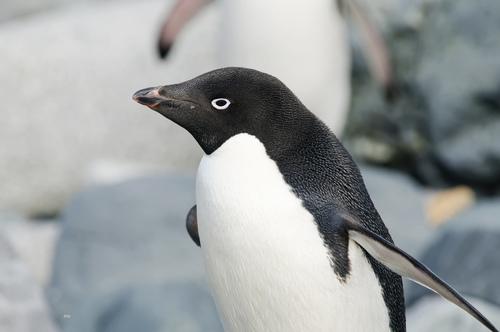
Adelie Penguin
The Adélie Penguin (*Pygoscelis adeliae*) is a charismatic and iconic species of penguin found exclusively along the Antarctic coastline and surrounding islands. They are vital components of the Antarctic ecosystem, serving as both predator and prey within the complex food web. Adélie Penguins are known for their remarkable adaptations to the harsh, icy environment and their large breeding colonies, which can number in the hundreds of thousands. While not currently considered globally threatened, they are sensitive indicators of climate change and shifts in the Antarctic marine environment. They hold no specific cultural significance in the same way some animals do in indigenous cultures due to their remote habitat, but they are symbolic of Antarctica and its unique wildlife.
Not applicable (wings modified into flippers) cm
Wingspan
Least Concern
Conservation Status
Distribution
Circumpolar, found exclusively along the Antarctic continent and nearby islands. They breed on ice-free rocky coastlines and islands during the Antarctic summer. During the non-breeding season (winter), they range further north in the pack ice and open sea, following the receding ice edge.
Lifespan
Typically 11-20 years in the wild, though some individuals may live longer.
Adelie Penguin's Habitat
Habitat Types
Rocky coastlines, Ice-free islands, Pack ice, Open ocean
Climate Zones
Antarctic
Adaptations
Adélie Penguins are highly adapted to cold, marine environments. They have dense, waterproof feathers and a thick layer of subcutaneous fat for insulation. Their streamlined bodies and powerful flippers allow for efficient swimming and diving. They also possess specialized salt glands above their eyes to excrete excess salt consumed from seawater.
Variations
No recognized subspecies exist. However, there can be slight variations in size and breeding timing between different colonies across their range.
Appearance
Breeding Plumage
Adults have a distinctive black back and head, with a white belly and a white ring surrounding the eye. There is no significant difference in plumage between breeding and non-breeding seasons.
Seasonal Feather Changes
Plumage may appear slightly duller after molting, which occurs annually after the breeding season.
Sex Based Plumage Differences
No significant sexual dimorphism in plumage.
Notable Features
White eye ring, Black head and back, White belly, Short, stubby tail
Diet and Feeding
Primary Foods
Krill, Small fish, Squid, Other crustaceans
Foraging Behavior
Adélie Penguins are pursuit divers, chasing prey underwater. They typically forage in relatively shallow waters, but can dive to depths of over 175 meters. They often forage in groups, potentially increasing their foraging efficiency.
Specializations
Their streamlined bodies and powerful flippers are specializations for underwater pursuit. Their tongues and palates are covered with rear-facing spines to help grip slippery prey.
Seasonal Diet Variations
Diet composition can vary depending on prey availability, which fluctuates seasonally and geographically. Krill often dominates the diet, particularly during the breeding season.
Behavior
Social Structure
Highly social, forming large breeding colonies that can number in the hundreds of thousands. Outside of the breeding season, they may form smaller groups at sea.
Communication
Vocalizations (squawks, trumpets, and calls), Visual displays (bowing, preening, head-shaking), Physical contact (flipper-to-flipper contact)
Migration
Adélie Penguins undertake extensive migrations between their breeding colonies and winter feeding grounds, often traveling thousands of kilometers. They follow the receding ice edge in the autumn and return to the breeding colonies in the spring.
Territorial or Group Behaviors
Within breeding colonies, Adélie Penguins are highly territorial, defending their nest site and immediate surroundings from other penguins. They use vocalizations and aggressive displays (pecking, flipper-beating) to defend their territory.
Conservation
Threats
Climate change (leading to sea ice loss and changes in prey availability), Overfishing of krill and other prey species, Oil spills and other pollution, Human disturbance at breeding colonies
Protection Programs
Antarctic Treaty System (provides general protection for the Antarctic environment), Commission for the Conservation of Antarctic Marine Living Resources (CCAMLR) (manages fisheries in the Southern Ocean), Marine Protected Areas (MPAs) (provide protection for key foraging and breeding areas)
Local National Laws
Protected under various national and international laws and agreements related to Antarctica and its wildlife.
Population Trend
Stable overall, but some regional populations are declining.
Population Estimates
Estimated at around 7.5 million breeding pairs.
Interesting Facts
Adélie Penguins can hold their breath for up to 6 minutes.
This allows them to dive deep in search of prey.
They can travel up to 300 kilometers on foot and by tobogganing (sliding on their bellies) across the ice to reach their breeding colonies.
This demonstrates their remarkable endurance and adaptation to the harsh Antarctic environment.
Adélie Penguins are named after Adélie Land in Antarctica, which in turn was named after the wife of French explorer Jules Dumont d'Urville.
This highlights the history of Antarctic exploration.
Stones are a valuable resource for Adelie Penguins.
Males will present females with stones as a courtship gift and they will use the stones to build their nest. Competition for stones can be fierce.
Faqs about Adelie Penguin
What do Adélie Penguins eat?
Adélie Penguins primarily eat krill, small fish, squid, and other crustaceans.
Where do Adélie Penguins live?
Adélie Penguins live exclusively along the Antarctic coastline and surrounding islands.
Are Adélie Penguins endangered?
Adélie Penguins are currently classified as Least Concern by the IUCN, but some populations are facing threats from climate change and overfishing.
How deep can Adélie Penguins dive?
While they typically forage in shallower waters, they have been recorded diving to depths exceeding 175 meters (574 feet).
Copyright @ Nature Style Limited. All Rights Reserved.

 English
English